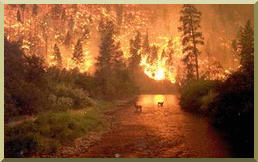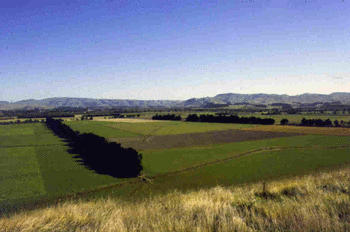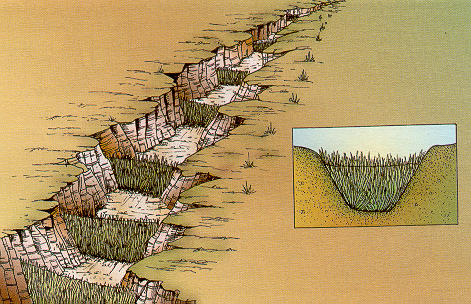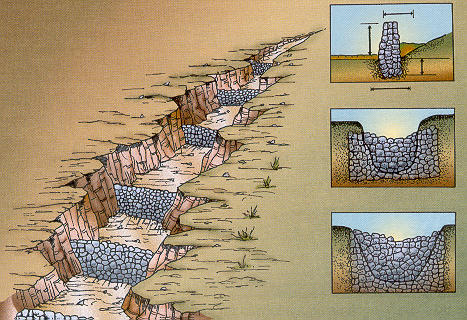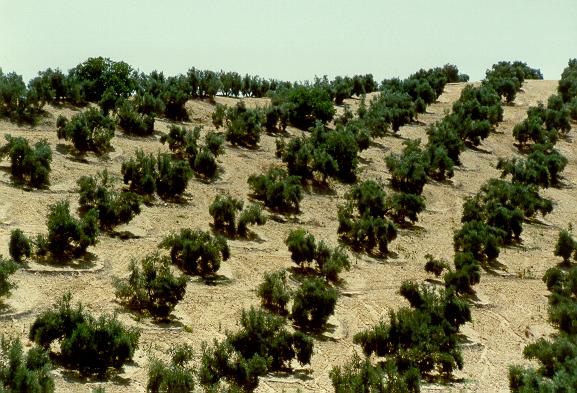|
|
| 4. DROUGHT MITIGATION |
|
Drought is a natural hazard, it has a slow onset, and
it evolves over months or even years. It may affect a
large region and causes little structural damage.
The impacts of drought can be reduced through preparedness and mitigation.
The components of a drought preparedness and mitigation plan are the following:
Prediction can benefit from climate studies which use coupled ocean/atmosphere models, survey of snow packs, anomalous circulation patterns in the ocean and atmosphere, soil moisture, assimilation of remotely sensed data into numerical prediction models, and knowledge of stored water available for domestic, stock, and irrigation uses. Monitoring exists in countries which use ground-based information such as rainfall, weather, crop conditions and water availability. Satellite observations complement data collected by ground systems. Satellites are necessary for the provision of synoptic, wide-area coverage. Impact assessment is carried out on the basis of land-use type, persistence of stressed conditions, demographics and existing infrastructure, intensity and areal extent, and its effect on agricultural yield, public health, water quantity and quality, and building subsidence. Response includes improved drought monitoring, better water and crop management, augmentation of water supplies with groundwater, increased public awareness and education, intensified watershed and local planning, reduction in water demand, and water conservation. Drought preparedness and mitigation can be accomplished with the following practices: (1) soil and water conservation, and (2) herd management. 4.1 Soil and Water Conservation Conservation practices minimize the disruption of the soil's structure, composition and natural biodiversity, thereby reducing erosion and soil degradation, surface runoff, and water pollution. The following are established practices of soil and water conservation:
|
|
|
Soil and water conservation can be approached through agronomic and engineering measures.
Agronomic measures include contour farming, off-season tillage, deep
tillage, mulching and providing vegetative barriers on the contour. These measures
prevent soil erosion and increase soil moisture.
Engineering measures differ with location, slope of the land, soil type, and amount and intensity of rainfall. Measures commonly used are the following:
These features prevent soil erosion and obstruct the flow of runoff. The retained water increases soil moisture and recharges the groundwater.
Check dams are temporary structures constructed with locally available materials. Types of check dams are the brush-wood dam (Fig. 2 a), the loose-rock dam (Fig. 2 b) and the woven-wire dam.
These features store water for livestock and recharge the groundwater. They are constructed by excavating a depression to form a small reservoir, or by constructing an embankment in a natural ravine or gully to form an impoundment.
|
|
|
Water-supply projects can also be implemented for drought mitigation, with a
view to strengthen drought preparedness.
Activities such as water-use planning, rain-water harvesting,
runoff collection using surface and underground structures,
improved management of channels and wells,
exploration of additional water resources through drilling and dam construction,
are implemented as a part of a drought-mitigation plan.
To increase moisture availability, the following in-situ moisture-conservation practices can be adopted:
|
|
|
Farmers can prepare for drought by developing plans which cover all
aspects of farm management and take into account variable climatic conditions.
Sustainable strategies
include appropriate fencing to control overgrazing,
pest-control measures,
planting drought-resistant crops and pasture,
stabilization of eroded soils,
pruning plants to reduce leaf area,
removing weak plants and thinning dense beds to reduce competition,
and the protection of native plant species.
4.2 Herd management Herd management is an important strategy for drought mitigation. Factors to be considered include the expected drought duration, the current water and feed supplies, the composition and body condition of the herd, and the financial resources available.
Herd management practices include the following:
When feed resources are getting short, one solution is to critically evaluate the members of the herd and eliminate those that are less useful. Sale or agistment (relocating herd to non-affected pastures) are the two options available to reduce stock numbers.
During a drought, the production of milk rapidly depletes a cow's body reserves, while the calf derives little benefit. Weaning the calf gives the cow a better chance of survival. However, the decision to wean must be made in relation to the time of year and age of the calf. In normal years, the nutritive value of pasture falls towards the end of autumn, at which time, beef cows may be producing as little as 1 liter of milk per day. If the calf is 5 to 6 months of age, weaning by the end of autumn will maintain or improve the cow's condition. In drought years, early weaning is recommended. However, calves should not be weaned before 3 months of age unless absolutely necessary. Young calves need to be fed some true protein meal or preferably milk powder. Most calves over three months of age will survive on grain and Lucerne hay or molasses and protein meal diets.
Segregating animals into classes gives the herd a better chance of getting needed feed supplies. Segregation makes possible the preferential treatment of vulnerable classes. The older dry cows can be moved to the poorer forage fields. Pregnancy testing is a useful tool to identify heavily pregnant cows for special feeding, especially young cows that are pregnant for a second time.
Cattle under nutritional and other stresses are less resistant to parasites than in normal conditions. Worms can be a serious problem with young cattle. During drought conditions, all cattle under 18 months of age should be treated for worms.
Cattle do not graze well areas located far away from watering points. Use of a drought-affected paddock can be encouraged by providing local water facilities, with supplementary hand feeding as an attractant.
Polluted surface waters represent a death trap for drought-weakened cattle. Fencing may be necessary to separate cattle from undesirable water holes. Salinity may increase with the depletion of the water table, with the water becoming too salty for the herd. The upper limit of total soluble salts should not exceed 8500 ppm. In addition, the sum of chlorides and sulphates of calcium and magnesium should not exceed 1400 ppm. Potential problems arising from drought conditions are:
|
| Definition of Drought | Impacts of Drought | Characteristics of Drought |
| Strategies for the Ojos Negros Valley | Summary | Drought Facts |
| http://ponce.sdsu.edu/three_issues_droughtfacts04.html | 021104 |
